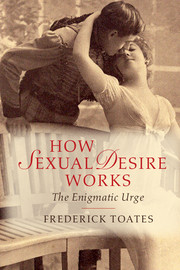Book contents
- Frontmatter
- Dedication
- Contents
- List of figures
- Preface
- One What is enigmatic about sexual desire?
- Two Explaining desire: multiple perspectives
- Three Sexual desire in a broad context
- Four An incentive-based model
- Five Sex and levels of organization
- Six Sexual attraction
- Seven Shades of desire from simple to complex
- Eight Details of the brain and desire
- Nine Arousal
- Ten The consequences of sexual behaviour and associated expectations
- Eleven Sexual familiarity and novelty
- Twelve Inhibition, conflict and temptation
- Thirteen How did sexual desire get here?
- Fourteen Setting the trajectory: link to adult sexuality
- Fifteen Sexual desire in interaction
- Sixteen Representations of sex
- Seventeen Sexual addiction
- Eighteen Variations in desire: general principles
- Nineteen Some forms of desire at the fringes
- Twenty The toxic fusion: violence and sexual desire
- Twenty one Sexually associated (serial) murder
- Twenty two Concluding remarks
- Notes
- References
- Index
Twenty one - Sexually associated (serial) murder
Published online by Cambridge University Press: 05 October 2014
- Frontmatter
- Dedication
- Contents
- List of figures
- Preface
- One What is enigmatic about sexual desire?
- Two Explaining desire: multiple perspectives
- Three Sexual desire in a broad context
- Four An incentive-based model
- Five Sex and levels of organization
- Six Sexual attraction
- Seven Shades of desire from simple to complex
- Eight Details of the brain and desire
- Nine Arousal
- Ten The consequences of sexual behaviour and associated expectations
- Eleven Sexual familiarity and novelty
- Twelve Inhibition, conflict and temptation
- Thirteen How did sexual desire get here?
- Fourteen Setting the trajectory: link to adult sexuality
- Fifteen Sexual desire in interaction
- Sixteen Representations of sex
- Seventeen Sexual addiction
- Eighteen Variations in desire: general principles
- Nineteen Some forms of desire at the fringes
- Twenty The toxic fusion: violence and sexual desire
- Twenty one Sexually associated (serial) murder
- Twenty two Concluding remarks
- Notes
- References
- Index
Summary
But many people are abnormal in their sexual life who in every other respect approximate to the average, and have, along with the rest, passed through the process of human cultural development, in which sexuality remains the weak spot.
(Freud, 1953, p. 149)What exactly is it?
Sexual homicide consists of (Burgess et al., 1986, p. 252): ‘one person killing another in the context of power, control, sexuality, and aggressive brutality’. A defining feature is: ‘the infliction of physical or psychological suffering on another person in order to achieve sexual excitement’.
The motivational basis
Not all serial killings arise from sexual motivation, though many do (Hickey, 2010). As a broad generalization, Buss (2005, p. 219): ‘serial killers murder because they seek vengeance for status denied’. Non-sexually linked serial killings are motivated by the desire for such things as attention, financial gain, political action (e.g. ‘mission killings’ to rid the world of undesirables) or ‘pure anger’ associated with retribution (Holmes and DeBurger, 1998).
- Type
- Chapter
- Information
- How Sexual Desire WorksThe Enigmatic Urge, pp. 409 - 441Publisher: Cambridge University PressPrint publication year: 2014

